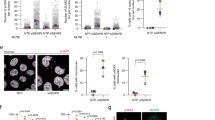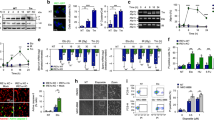Abstract
The nicotinamide adenine dinucleotide (NAD)-dependent deacetylase Sir2 (silent information regulator 2) regulates gene silencing in yeast and promotes lifespan extension during caloric restriction. The mammalian homologue of Sir2 (SirT1) regulates p53, NF-κB and Forkhead transcription factors, and is implicated in stress response. This report shows that the cell-cycle and apoptosis regulator E2F1 induces SirT1 expression at the transcriptional level. Furthermore, SirT1 binds to E2F1 and inhibits E2F1 activities, forming a negative feedback loop. Knockdown of SirT1 by small interference RNA (siRNA) increases E2F1 transcriptional and apoptotic functions. DNA damage by etoposide causes E2F1-dependent induction of SirT1 expression and knockdown of SirT1 increases sensitivity to etoposide. These results reveal a mutual regulation between E2F1 and SirT1 that affects cellular sensitivity to DNA damage.
This is a preview of subscription content, access via your institution
Access options
Subscribe to this journal
Receive 12 print issues and online access
We are sorry, but there is no personal subscription option available for your country.
Buy this article
- Purchase on SpringerLink
- Instant access to full article PDF
Prices may be subject to local taxes which are calculated during checkout




Similar content being viewed by others
References
Guarante, L. P. Regulation of aging by SIR2. Ann. N. Y. Acad. Sci. 1055, 222 (2005).
Anderson, R. M., Bitterman, K. J., Wood, J. G., Medvedik, O. & Sinclair, D. A. Nicotinamide and PNC1 govern lifespan extension by calorie restriction in Saccharomyces cerevisiae. Nature 423, 181–185 (2003).
Tissenbaum, H. A. & Guarente, L. Increased dosage of a sir-2 gene extends lifespan in Caenorhabditis elegans. Nature 410, 227–230 (2001).
Lin, S. J., Defossez, P. A. & Guarente, L. Requirement of NAD and SIR2 for life-span extension by calorie restriction in Saccharomyces cerevisiae. Science 289, 2126–2128 (2000).
Vaziri, H. et al. hSIR2(SIRT1) functions as an NAD-dependent p53 deacetylase. Cell 107, 149–159 (2001).
Luo, J. et al. Negative control of p53 by Sir2α promotes cell survival under stress. Cell 107, 137–148 (2001).
Langley, E. et al. Human SIR2 deacetylates p53 and antagonizes PML/p53-induced cellular senescence. EMBO J. 21, 2383–2396 (2002).
Brunet, A. et al. Stress-dependent regulation of FOXO transcription factors by the SIRT1 deacetylase. Science 303, 2011–2015 (2004).
Yang, Y., Hou, H., Haller, E. M., Nicosia, S. V. & Bai, W. Suppression of FOXO1 activity by FHL2 through SIRT1-mediated deacetylation. EMBO J. 24, 1021–1032 (2005).
Nahle, Z. et al. Direct coupling of the cell cycle and cell death machinery by E2F. Nature Cell Biol. 4, 859–864 (2002).
Johnson, D. G., Schwarz, J. K., Cress, W. D. & Nevins, J. R. Expression of transcription factor E2F1 induces quiescent cells to enter S phase. Nature 365, 349–352 (1993).
Wu, X. & Levine, A. J. p53 and E2F-1 cooperate to mediate apoptosis. Proc. Natl Acad. Sci. USA 91, 3602–3606 (1994).
Lin, W. C., Lin, F. T. & Nevins, J. R. Selective induction of E2F1 in response to DNA damage, mediated by ATM-dependent phosphorylation. Genes Dev. 15, 1833–1844 (2001).
Ma, Y., Yuan, J., Huang, M., Jove, R. & Cress, W. D. Regulation of the cyclin D3 promoter by E2F1. J. Biol. Chem. 278, 16770–16776 (2003).
Ma, Y., Cress, W. D. & Haura, E. B. Flavopiridol-induced apoptosis is mediated through up-regulation of E2F1 and repression of Mcl-1. Mol. Cancer Ther. 2, 73–81 (2003).
Nemoto, S., Fergusson, M. M. & Finkel, T. Nutrient availability regulates SIRT1 through a forkhead-dependent pathway. Science 306, 2105–2108 (2004).
Yeung, F. et al. Modulation of NF-RB-dependent transcription and cell survival by the SIRT1 deacetylase. EMBO J. 23, 2369–2380 (2004).
Ma, Y., Freeman, S. N. & Cress, W. D. E2F4 deficiency promotes drug-induced apoptosis. Cancer Biol. Ther. 3, 1262–1269 (2004).
Dyson, N. The regulation of E2F by pRB-family proteins. Genes Dev. 12, 2245–2262 (1998).
Stevens, C., Smith, L. & La Thangue, N. B. Chk2 activates E2F-1 in response to DNA damage. Nature Cell Biol. 5, 401–409 (2003).
Johnson, D. G., Ohtani, K. & Nevins, J. R. Autoregulatory control of E2F1 expression in response to positive and negative regulators of cell cycle progression. Genes Dev. 8, 1514–1525 (1994).
Martinez-Balbas, M. A., Bauer, U. M., Nielsen, S. J., Brehm, A. & Kouzarides, T. Regulation of E2F1 activity by acetylation. EMBO J. 19, 662–671 (2000).
Luo, R. X., Postigo, A. A. & Dean, D. C. Rb interacts with histone deacetylase to repress transcription. Cell 92, 463–473 (1998).
Kowalik, T. F., DeGregori, J., Leone, G., Jakoi, L. & Nevins, J. R. E2F1-specific induction of apoptosis and p53 accumulation, which is blocked by Mdm2. Cell Growth Differ. 9, 113–118 (1998).
Wang, C. et al. Activation of p27Kip1 Expression by E2F1. A negative feedback mechanism. J. Biol. Chem. 280, 12339–12343 (2005).
Pruschy, M., Wirbelauer, C., Glanzmann, C., Bodis, S. & Krek, W. E2F-1 has properties of a radiosensitizer and its regulation by cyclin A kinase is required for cell survival of fibrosarcoma cells lacking p53. Cell Growth Differ. 10, 141–146 (1999).
Chen, W. Y. et al. Tumor suppressor HIC1 directly regulates SIRT1 to modulate p53-dependent DNA-damage responses. Cell 123, 437–448 (2005).
Chu, F., Chou, P. M., Zheng, X., Mirkin, B. L. & Rebbaa, A. Control of multidrug resistance gene mdr1 and cancer resistance to chemotherapy by the longevity gene sirt1. Cancer Res. 65, 10183–10187 (2005).
Ford, J., Jiang, M. & Milner, J. Cancer-specific functions of SIRT1 enable human epithelial cancer cell growth and survival. Cancer Res. 65, 10457–10463 (2005).
Rogoff, H. A. et al. Apoptosis associated with deregulated E2F activity is dependent on E2F1 and Atm–Nbs1–Chk2. Mol. Cell Biol. 24, 2968–2977 (2004).
Acknowledgements
We would like to thank T. Kowalik for the E7 adenovirus, T. Kouzarides for the E2F13R mutant and M. McBurney for SirT1-null MEFs. We also thank the Moffitt Molecular Biology and Flow Cytometry Cores for sequencing and FACS analyses. This work was supported by grants from the National Institutes of Health (NIH) and American Cancer Society (ACS) to J. Chen.
Author information
Authors and Affiliations
Corresponding author
Ethics declarations
Competing interests
The authors declare no competing financial interests.
Supplementary information
Supplementary Information
Supplementary Figures S1, S2, S3 and S4 (PDF 4635 kb)
Rights and permissions
About this article
Cite this article
Wang, C., Chen, L., Hou, X. et al. Interactions between E2F1 and SirT1 regulate apoptotic response to DNA damage. Nat Cell Biol 8, 1025–1031 (2006). https://doi.org/10.1038/ncb1468
Received:
Accepted:
Published:
Issue Date:
DOI: https://doi.org/10.1038/ncb1468
This article is cited by
-
RUNX3 mediates keloid fibroblast proliferation through deacetylation of EZH2 by SIRT1
BMC Molecular and Cell Biology (2022)
-
Nucleolar protein NOC4L inhibits tumorigenesis and progression by attenuating SIRT1-mediated p53 deacetylation
Oncogene (2022)
-
Sirt1 deficiency upregulates glutathione metabolism to prevent hepatocellular carcinoma initiation in mice
Oncogene (2021)
-
Sirtuin 1 inhibits lipopolysaccharide-induced inflammation in chronic myelogenous leukemia k562 cells through interacting with the Toll-like receptor 4-nuclear factor κ B-reactive oxygen species signaling axis
Cancer Cell International (2020)
-
Ubiquitination-mediated degradation of SIRT1 by SMURF2 suppresses CRC cell proliferation and tumorigenesis
Oncogene (2020)



